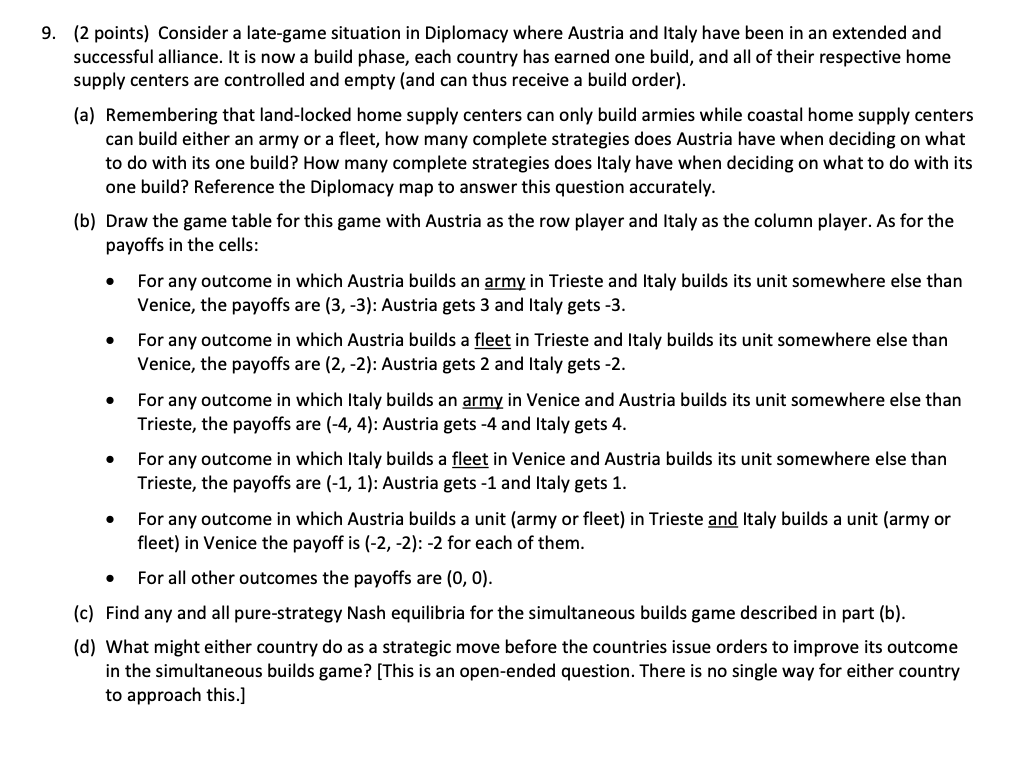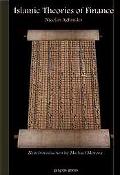
9. (2 points) Consider a late-game situation in Diplomacy where Austria and Italy have been in an extended and successful alliance. It is now a build phase, each country has earned one build, and all of their respective home supply centers are controlled and empty (and can thus receive a build order). (a) Remembering that land-locked home supply centers can only build armies while coastal home supply centers can build either an army or a fleet, how many complete strategies does Austria have when deciding on what to do with its one build? How many complete strategies does Italy have when deciding on what to do with its one build? Reference the Diplomacy map to answer this question accurately. (b) Draw the game table for this game with Austria as the row player and Italy as the column player. As for the payoffs in the cells: For any outcome in which Austria builds an army in Trieste and Italy builds its unit somewhere else than Venice, the payoffs are (3,-3): Austria gets 3 and Italy gets -3. For any outcome in which Austria builds a fleet in Trieste and Italy builds its unit somewhere else than Venice, the payoffs are (2,-2): Austria gets 2 and Italy gets -2. For any outcome in which Italy builds an army in Venice and Austria builds its unit somewhere else than Trieste, the payoffs are (-4,4): Austria gets -4 and Italy gets 4. For any outcome in which Italy builds a fleet in Venice and Austria builds its unit somewhere else than Trieste, the payoffs are (-1, 1): Austria gets -1 and Italy gets 1. For any outcome in which Austria builds a unit (army or fleet) in Trieste and Italy builds a unit (army or fleet) in Venice the payoff is (-2,-2): -2 for each of them. . For all other outcomes the payoffs are (0,0). (c) Find any and all pure-strategy Nash equilibria for the simultaneous builds game described in part (b). (d) What might either country do as a strategic move before the countries issue orders to improve its outcome in the simultaneous builds game? [This is an open-ended question. There is no single way for either country to approach this.] 9. (2 points) Consider a late-game situation in Diplomacy where Austria and Italy have been in an extended and successful alliance. It is now a build phase, each country has earned one build, and all of their respective home supply centers are controlled and empty (and can thus receive a build order). (a) Remembering that land-locked home supply centers can only build armies while coastal home supply centers can build either an army or a fleet, how many complete strategies does Austria have when deciding on what to do with its one build? How many complete strategies does Italy have when deciding on what to do with its one build? Reference the Diplomacy map to answer this question accurately. (b) Draw the game table for this game with Austria as the row player and Italy as the column player. As for the payoffs in the cells: For any outcome in which Austria builds an army in Trieste and Italy builds its unit somewhere else than Venice, the payoffs are (3,-3): Austria gets 3 and Italy gets -3. For any outcome in which Austria builds a fleet in Trieste and Italy builds its unit somewhere else than Venice, the payoffs are (2,-2): Austria gets 2 and Italy gets -2. For any outcome in which Italy builds an army in Venice and Austria builds its unit somewhere else than Trieste, the payoffs are (-4,4): Austria gets -4 and Italy gets 4. For any outcome in which Italy builds a fleet in Venice and Austria builds its unit somewhere else than Trieste, the payoffs are (-1, 1): Austria gets -1 and Italy gets 1. For any outcome in which Austria builds a unit (army or fleet) in Trieste and Italy builds a unit (army or fleet) in Venice the payoff is (-2,-2): -2 for each of them. . For all other outcomes the payoffs are (0,0). (c) Find any and all pure-strategy Nash equilibria for the simultaneous builds game described in part (b). (d) What might either country do as a strategic move before the countries issue orders to improve its outcome in the simultaneous builds game? [This is an open-ended question. There is no single way for either country to approach this.]







